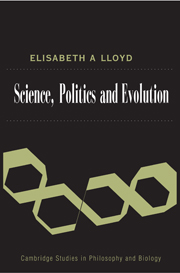Book contents
- Frontmatter
- Contents
- 1 The Nature of Darwin's Support for the Theory of Natural Selection
- 2 A Semantic Approach to the Structure of Population Genetics
- 3 Confirmation of Ecological and Evolutionary Models
- 4 Units and Levels of Selection
- 5 Species Selections on Variability
- 6 An Open Letter to Elliott Sober and David Sloan Wilson, Regarding Their Book, Unto Others: The Evolution and Psychology of Unselfish Behavior
- 7 Problems with Pluralism
- 8 Normality and Variation: The Human Genome Project and the Ideal Human Type
- 9 Evolutionary Psychology: The Burdens of Proof
- 10 Objectivity and the Double Standard for Feminist Epistemologies
- 11 Science and Anti-Science: Objectivity and Its Real Enemies
- 12 Pre-Theoretical Assumptions in Evolutionary Explanations of Female Sexuality
- References
- Index
4 - Units and Levels of Selection
Published online by Cambridge University Press: 27 February 2010
- Frontmatter
- Contents
- 1 The Nature of Darwin's Support for the Theory of Natural Selection
- 2 A Semantic Approach to the Structure of Population Genetics
- 3 Confirmation of Ecological and Evolutionary Models
- 4 Units and Levels of Selection
- 5 Species Selections on Variability
- 6 An Open Letter to Elliott Sober and David Sloan Wilson, Regarding Their Book, Unto Others: The Evolution and Psychology of Unselfish Behavior
- 7 Problems with Pluralism
- 8 Normality and Variation: The Human Genome Project and the Ideal Human Type
- 9 Evolutionary Psychology: The Burdens of Proof
- 10 Objectivity and the Double Standard for Feminist Epistemologies
- 11 Science and Anti-Science: Objectivity and Its Real Enemies
- 12 Pre-Theoretical Assumptions in Evolutionary Explanations of Female Sexuality
- References
- Index
Summary
INTRODUCTION
Richard Lewontin was the first to investigate systematically the set of problems raised by a hierarchical expansion of selection theory in his landmark 1970 article. His classic abstraction and analysis of the three principles of evolution by natural selection – phenotypic variation, differential fitness, and heritability of fitness – have served as the launching point for many biologists and philosophers who have wrestled with units of selection problems. Lewontin's critical discussion of the empirical evidence for selection at various biological levels has served as both touchstone and target for later work. But Lewontin's essay was addressed to the efficacy of different units of selection as causes of evolutionary change (1970, p. 7). In the analysis I offer in this chapter, this is but one of four distinct questions involved in the contemporary units of selection debates.
For at least two decades, some participants in the “units of selection” debates have argued that more than one question is at stake. Richard Dawkins, for instance, introduced the terms replicator and vehicle to stand for different roles in the evolutionary process (1978; 1982a; 1982b). He proceeded to argue that the units of selection debate should not be about vehicles, as it had formerly been, but about replicators. David Hull, in his influential article, “Individuality and Selection” (1980), suggested that Dawkins's “replicator” subsumes two distinct functional roles, and the separate categories of “replicator,” “interactor,” and “evolver” were born.
- Type
- Chapter
- Information
- Science, Politics, and Evolution , pp. 59 - 83Publisher: Cambridge University PressPrint publication year: 2008
- 1
- Cited by

